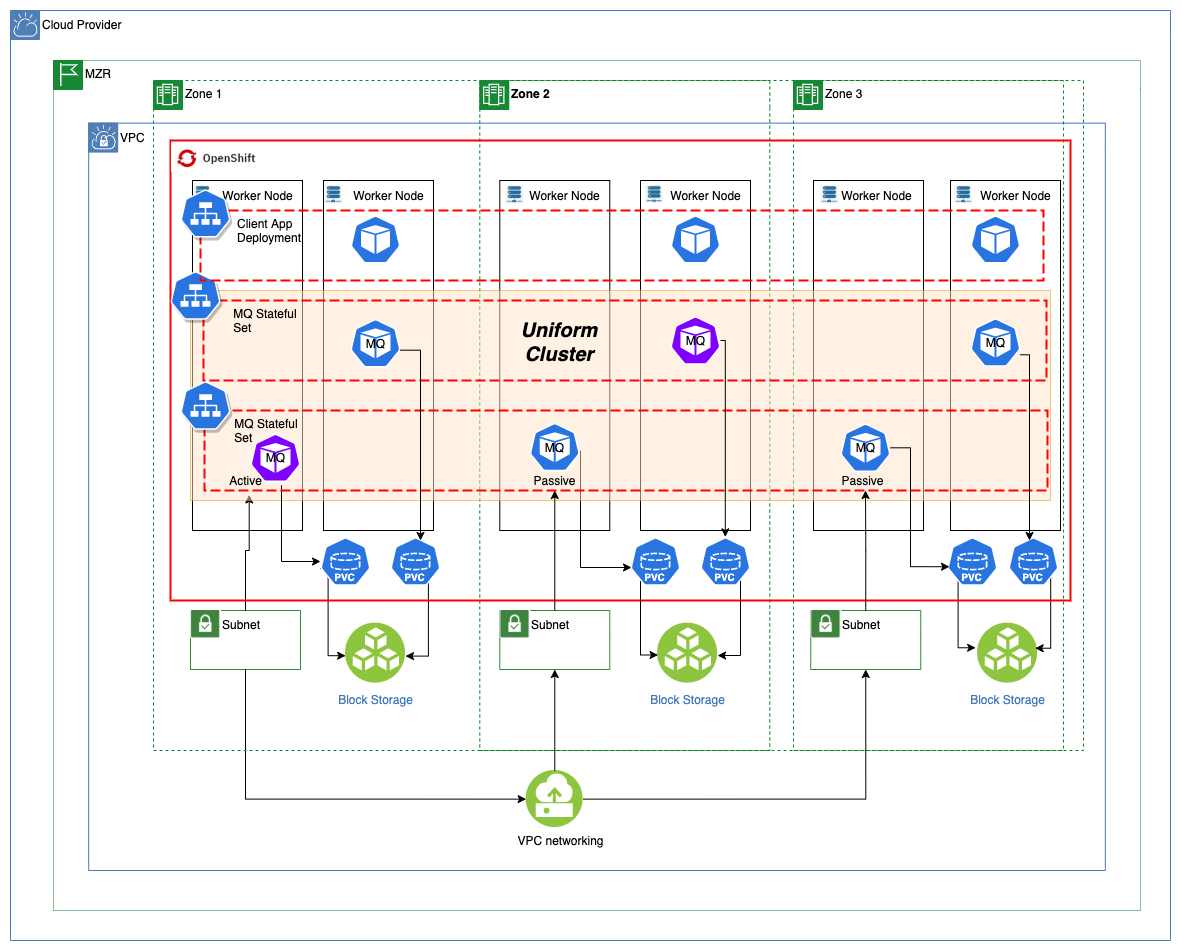MQ High Availability Architectures: In-Region Active Active¶
Warning
Work in Progress
Overview¶
Audience: Architects, Application developers, Administrators
In this topic, we're going to:
- review the essential elements of what provides NativeHA high-availability to the latest versions of IBM MQ
- understand the impact at the infrastructure, services, and application tiers which a multi-instance, high-availability requirement brings
- discuss in-region, multi-instance deployment characteristics and needs
- deploy this topology to your OpenShift cluster
Architecture Overview¶

The following components comprise the high-availability topology at a high level. As your desired topology evolves to reduce single points of failure, this list will become more robust in nature.
-
Virtual Private Cloud:
- Distribute workloads across a minimum of three (3) sets of infrastructure service resources in 3 distinct availability zones (AZ).
-
Red Hat OpenShift Container Platform:
- Minimum two (2) OpenShift Compute Nodes per AZ to achieve standard OpenShift SLOs (99.99% possible).
-
IBM MQ - Native HA Queue Manager:
- Requires a minimum of one (1) OpenShift Node in each AZ for normal mode operations.
- Requires a minimum of two (2) OpenShift Nodes in each AZ during OpenShift Node maintenance.
- Requires a Uniform Cluster with at least two unique Queue Manager instances as members.
-
MQ Client Application:
- Stateless container-based client application.
- Leverage anti-affinity deployment practices, where possible.
- Utilizing CCDT (client channel definition table) connection patterns.
Single Points of Failure¶
These services and infrastructure components have been identified as potential single points of failure in this topology:
- Red Hat OpenShift Container Platform
- Regional Cloud Networking
- Regional Cloud Storage
- Regional Cloud Ingress/Egress
The Queue Manager has been removed from this list (first established in the In-Region Active Passive - Single Points of Failure section), as there are now multiple Queue Manager instances deployed in unison as a Uniform Cluster.
Infrastructure Requirements¶
This topology, as it extends the simplest topology which still provides high-availability, it also requires the least amount of bespoke support from the underlying infrastructure.
- Block Storage with ReadWriteOnce support
- Multiple availability zones inside of a single region
MQ Assets¶
Warning
TODO Uniform clusters (mqsc/ini)
All of the high-availability topologies in this deployment guide leverage the NativeHA feature of IBM MQ for resiliency. As the topologies grow more complex, additional configurations and deployments are added to this least-common architectural denominator.
The recently released NativeHA capability allows for multiple QueueManager pods to be running, with only one of them truly being "active" and receiving traffic from the OpenShift Route or Service. The running pods, managed by a StatefulSet on the underlying Kubernetes-based platform, actively share log and message data between the active and passive QueueManager instances. Once the active QueueManager instance becomes unavailable for any reason, the remaining passive pods take advantage of the RAFT algorithm to elect a new leader and within seconds failover to a different QueueManager instance, while minimizing service and message unavailability.
For more details on the early release of NativeHA for IBM MQ 9.2, you can check out the official IBM MQ Docs.
Our example here sets the following properties in the QueueManager YAML file and pushes the changes to your GitOps repo:
availability:
type: NativeHA
tls:
secretName: <inter-queuemanager-tls-cert-secret>
cipherSpec: ANY_TLS12_OR_HIGHER
storage:
defaultClass: ibmc-vpc-block-metro-10iops-tier
queueManager:
enabled: true
size: 2Gi
type: persistent-claim
- The
availability.typesetting is required to beNativeHAto take advantage of this capability. - The
availability.tlssetting allows for TLS-encrypted communication between QueueManager instances in the StatefulSet. - The
storage.defaultClasssetting should point to a multi-AZ supported storage class the provides ReadWriteOnce storage capability for Block Storage. - The
storage.queueManagersetting is required to be enabled and set to typepersistent-claimfor NativeHA fail-over capability to function.
Client Application Recommendations¶
Warning
TODO CCDT
Our sample client application is available under the Building MQ applications section. There are minimal additional configuration requirements to deploy the client application connected to this topology.
To be addressed:
- Automatic client reconnection
- Connects to a single Route URL provided by the MQ QueueManager instance
- As only a single region is deployed, there is no consideration given for message sequencing needs beyond traditional single QueueManager requirements.